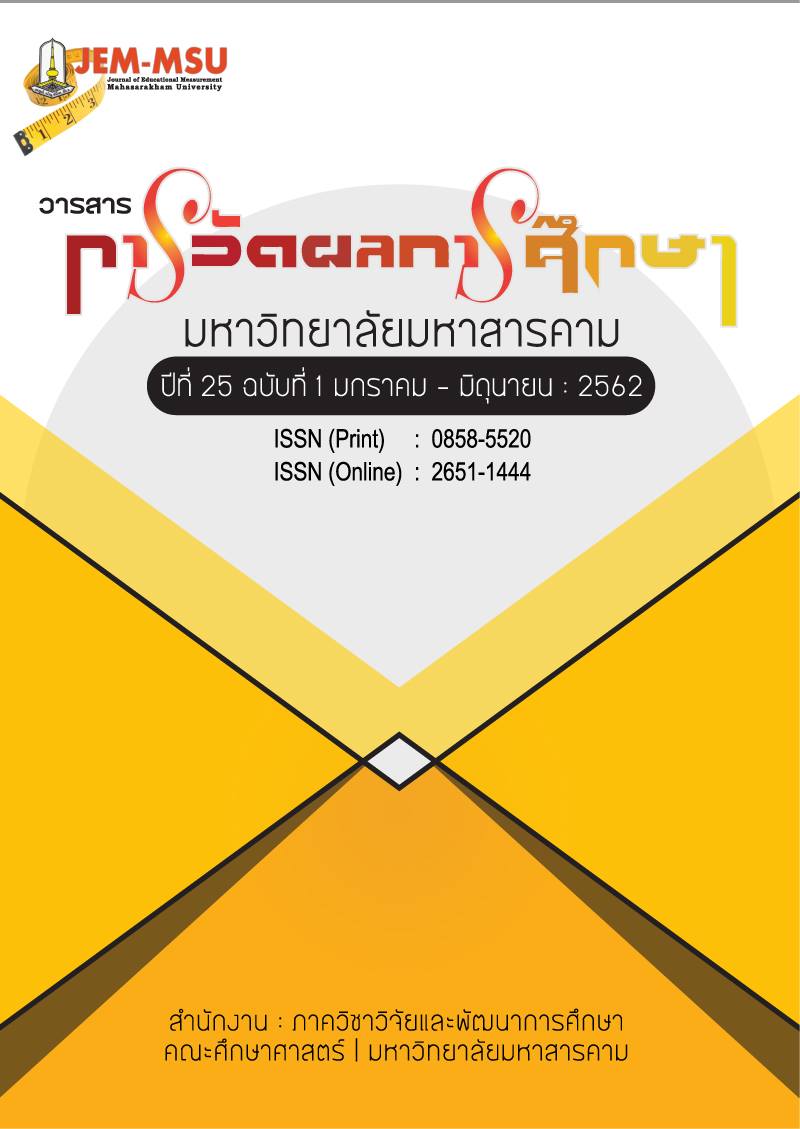Development of a Model of Organizing for Learning For Enhancement of Reflective Thinking Ability of Student Teachers
Main Article Content
Abstract
The research and development aimed to develop and study the effect of the model of organizing for learning for enhancement of reflective thinking ability of student teachers. The research was designed to have 4 steps. Step 1 was the study on basic data. Step 2 was the development of the model. Step 3 was the implementation of the model, and Step 4 was improvement of the model. The population consisted of 270 third year B.Ed. students who were studying the Principles of Organizing for Learning Course in the first semester of the academic year 2017 at the Faculty of Education, Ubon Ratchathani Rajabhat University. The student teachers were from 9 majors; one group from each major: General Science, English, Physical Education, Early Childhood Education, Special Education and Computer, Elementary Education, Social Studies, Computer and Educational Technology, and Mathematics. The sample consisted of 31 3rd year B.Ed. students from the General Science program, obtained through cluster random sampling. The research tools were the model of organizing for learning, a reflective thinking ability assessment form, a learning log, a reflective thinking behavior observation form, and a questionnaire inquiring satisfaction with the model. The statistics employed in the analysis of data were the mean and standard deviation. And t-test (for dependent samples) was used in hypothesis testing.
The research results are as follows:
1. The model of organizing for learning for enhancement of reflective thinking ability of student teachers that had been developed contained 6 components. They were: background and significance, objective, principle, steps of organizing learning activities, media/learning sources, and measurement and evaluation. According to the model, there were 6 steps of organizing for learning: the “S4CL.” It comprised self-learning, collaborative learning, collaborative sharing, collaborative constructing, collaborative evaluation, and learning log and reflective writing.
2. The study of the effect of the model revealed that after learning, the student teachers had higher scores of reflective thinking ability than before learning, with statistical significance at the .05 level; and the development of reflective thinking behavior from 3 periods of observation tended to be higher. The student teachers expressed satisfaction with the model at the highest level. ( = 4.52). The learning log content analysis result revealed that the model could develop reflective thinking ability of student teachers well.
Article Details
The content and information contained in the published article in the Journal of Educational Measurement Mahasarakham University represent the opinions and responsibilities of the authors directly. The editorial board of the journal is not necessarily in agreement with or responsible for any of the content.
The articles, data, content, images, etc. that have been published in the Journal of Educational Measurement Mahasarakham University are copyrighted by the journal. If any individual or organization wishes to reproduce or perform any actions involving the entirety or any part of the content, they must obtain written permission from the Journal of Educational Measurement Mahasarakham University.
References
กระทรวงศึกษาธิการ. (2554). ประกาศกระทรวงศึกษาธิการ เรื่อง มาตรฐานคุณวุฒิระดับปริญญาตรีสาขาครุศาสตร์/ศึกษาศาสตร์. (หลักสูตรห้าปี). กรุงเทพฯ : กระทรวงศึกษาธิการ.
กนกนุช ชื่นเลิศสกุล. (2544). การเรียนรู้โดยผ่านการสะท้อนคิด: การศึกษาและการปฏิบัติการพยาบาลในคลินิก. วารสารคณะพยาบาลศาสตร์ มหาวิทยาลัยบูรพา, 9(2), 35-48.
เชษฐา แก้วพรหม. (2556). การพัฒนาทักษะสะท้อนคิดของนักศึกษาพยาบาลด้วยการเขียนบันทึกการเรียนรู้ในรายวิชาการสอนและการให้คำปรึกษาทางสุขภาพ. วารสารวิทยาลัยพยาบาลพระปกเกล้าจันทบุรี, 24(2), 12-20.
ประวิต เอราววรรณ์. (2558). ระบบการผลิตครูโดยใช้โรงเรียนสุขภาวะเป็นฐาน. วารสารคณะครุศาสตร์ มหาวิทยาลัยราชภัฏสุราษฎร์ธานี. 1 (1): 2-6.
ประเวศ วะสี. (2554). ระบบการศึกษาที่แก้ความทุกข์ยากของคนทั้งแผ่นดิน. (พิมพ์ครั้งที่ 2). นครปฐม : ศูนย์จิตตปัญญาศึกษา มหาวิทยาลัยมหิดล.
ปาลีรัญญ์ ฐาสิรสวัสดิ์. (2555). ความสำคัญของการสะท้อนคิด. [ออนไลน์]. ได้จาก : http://app2.pnc.ac.th/km/?p=963 [สืบค้นเมื่อ วันที่ 21 มีนาคม 2560].
ลำเจียก กำธร, ฐิณัฐตา ศุภศรี และฐาปนี อัครสุวรรณกุล. (2560). การพัฒนาการจัดการเรียนการสอนเพื่อส่งเสริมทักษะการสะท้อนคิดของนักศึกษาพยาบาล ในรายวิชาปฏิบัติการพยาบาลบุคคลที่มีปัญหาทางจิต. วารสารเครือข่ายวิทยาลัยพยาบาลและการสาธารณสุขภาคใต้. 4 (1) : 15-27.
วิเชียร ไชยบัง. (2558). จิตศึกษากับการพัฒนาปัญญาภายใน. พิมพ์ครั้งที่ 2.บุรีรัมย์ : สำนักพิมพ์เรียนนอกกะลา.
ศิราณี เก็จกรแก้ว. (2552). การจัดการเรียนการสอนภาคปฏิบัติโดยวิธีการส่งเสริมการสะท้อนคิด. วารสารการพยาบาลและสุขภาพ, 3(3): 10-17
ศิรินทิพย์ รักษาสัตย์, กิ่งฟ้า สินธุวงษ์ และปัฐมาภรณ์ พิมพ์ทอง. (2549). “กระบวนการสะท้อนผลสำหรับการฝึกงานครูในสถานศึกษา” การฝึกประสบการณ์วิชาชีพครู III. ขอนแก่น : คณะศึกษาศาสตร์ มหาวิทยาลัยขอนแก่น.
สมหวัง พิธิยานุวัฒน์. (2544). รวมบทความทางการประเมินโครงการ. กรุงเทพฯ: สำนักพิมพ์แห่งจุฬาลงกรณ์.
สุพรรณิการ์ ชนะนิล. (2557). การพัฒนากิจกรรมการเรียนรู้ของนักศึกษาครูด้วยกิจกรรมสะท้อนคิด โดยใช้รูปแบบ 3-R ในรายวิชาการวัดผลและประเมินผลทางคณิตศาสตร์. [ออนไลน์]. ได้จาก : https://rerujournal.reru.ac.th/wp-content/uploads/2018/03/OK-26-A5.pdf [สืบค้นวันที่ 21 มีนาคม 2560].
สัจธรรม พรทวีกุล. (2557). รูปแบบการเรียนการสอนการคิดไตร่ตรองของนักศึกษาครู. รมยสาร. 12 (1) : 57-67.
สำนักงานเลขาธิการสภาการศึกษา. (2558). รายงานผลการศึกษา : สถานภาพการผลิตและพัฒนาครูในประเทศไทย. กรุงเทพฯ : พริกหวาน กราฟฟิค
สำนักงานคณะกรรมการการศึกษาแห่งชาติ. (2542). พระราชบัญญัติการศึกษาแห่งชาติ พ.ศ.2542. กรุงเทพฯ: สำนักงานคณะกรรมการการศึกษาแห่งชาติ สำนักนายกรัฐมนตรี.
Baldwin, J. and H. Williams. (1988). Active learning: a trainer’s guide. Oxford: Blackwell
Barber, Michael. (2009). The Challenge of Achieving World Class Performance: Education in the 21 st Century. Minneapolis : n.p.
Bonwell, C.C., J.A. Eison. (1991). “Active Learning: Creating Excitement in the Classroom.” ERIC Digest. Washington D.C.: ERIC Clearinghouse on Higher Education.
Brookfield, S.D. (1995). Becoming a Critically Reflective Teacher. Jossey-Bass, San Francisco.
Demissie, F. (2015). Promoting Student Teachers' Reflective Thinking Through a Philosophical Community of Enquiry Approach. Australian Journal of Teacher Education, 40(12).
Dewey, G., R. Jucker, and S. Martin. (2005). Sustainable development in higher education: current practice and future developments. A report for the Higher Education
Academy. [Online]. Available from: www.heacademy.ac.uk/assets/ York/documents/
ourwork/tla/sustainability
Dewey, J.. (1933). How we think: a restatement of the relation of reflective thinking and the educational process. New York: D.C Heath.
Farrell, T.S.C. (2001). Tailoring reflection to individual needs : a TESOL case study in Journal of Education for Teaching, (27) : 23-28.
Garmston, R. ; Linda,C. ;& Whitaker, J. (1993). “Reflections on Cognitive Coaching”, Educational Leadership. 51 (2) : 57–61.
Gibbs, G. (1988). Learning by doing: A guide to teaching learning methods. Oxford: Oxford Brookes University.
Joyce, B. and Weil, M. (2010). Model of Teaching. United States of America Prenice Hall International.
Kember et al. (2000). “Development of a questionnaire to measure the level of reflective thinking”, Assessment & Evaluation in Higher Education, 25(A), pp. 381-395.
Kolb, D. (1984). Experiential learning. London: Prentice Hall
Kruse, K. (2009). Introduction to Instructional Design and the ADDIE model. [Online]. Available from: www.e-learningguru.com/article/art2_1htm.
Lilia & et al. (2010). Guiding student teachers to be reflective. Procedia Social and Behavioral Sciences. 18 (2011). 544–550
Mezirow and Associates. (1990). Fostering critical reflection in adulthood. San Francisco: Jossey-Bass.
Schon, D. (1987). Educating the reflective practitioner : toward a new design for teaching and learning in the profession. San Francisco : Jossey-Bass.
Taggart, G.L. (2005). Becoming reflective teacher. [Online]. Available from: www.sagepub.com/upm-data/6681taggartch1.pdf.


